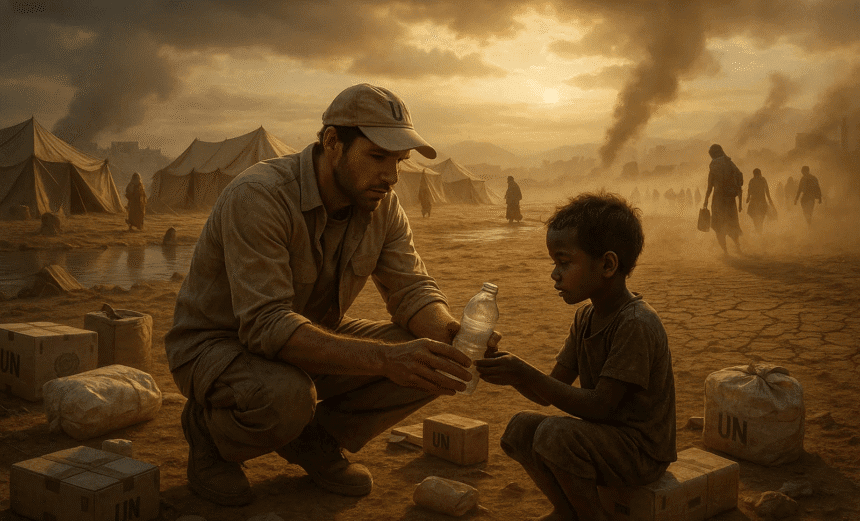Around the world, war, political turmoil, and climate disasters are colliding to create an unprecedented humanitarian emergency. According to the UN Office for the Coordination of Humanitarian Affairs (OCHA), more than 360 million people now require urgent aid, yet global response plans are less than 50% funded. From Sudan to Syria, Palestine, Myanmar, and across Africa, millions are trapped between relentless conflict and the collapse of essential services, pushing entire regions to the brink of famine and instability.
In Sudan, what began in April 2023 as a power struggle between the Sudanese Armed Forces and the Rapid Support Forces has spiraled into one of the largest displacement crises in modern history. More than 30 million Sudanese need humanitarian aid, with 9 million internally displaced and 4 million forced to flee into neighboring countries such as Chad, South Sudan, and Egypt. Entire cities have been destroyed, food production has halted, and famine-like conditions are emerging in parts of Darfur and Kordofan. Aid agencies report that convoys are routinely looted or blocked, leaving vast areas inaccessible. The United Nations warns that without immediate funding and safe humanitarian corridors, millions could face starvation before the end of 2025.
In the Middle East, the situation in Palestine, particularly in Gaza, has reached catastrophic levels. More than 68,000 Palestinians have been killed since the escalation of violence in October 2023, and nearly 90% of Gaza’s 2.1 million people have been displaced at least once. Entire neighborhoods lie in ruins, hospitals are overwhelmed, and clean water and food are nearly impossible to access. The ongoing blockade has cut off essential supplies, leading to widespread disease, hunger, and trauma among civilians. In the West Bank, rising settler violence, economic restrictions, and mass arrests continue to fuel tension and despair. Humanitarian organizations warn that Gaza’s collapse is not just a regional tragedy but a global test of the world’s commitment to human rights and international law.
In Syria, more than fourteen years of war have left the country in ruins. Over 16 million Syrians, nearly three-quarters of the population, depend on humanitarian assistance, while about 7 million remain displaced within the country’s borders. Prolonged drought, economic sanctions, and decimated infrastructure have pushed millions toward starvation. Health services are barely functioning, and many families survive on one meal a day. Aid groups warn that funding cuts could soon force the suspension of essential food and medical programs, deepening an already desperate situation.
Further east, Myanmar continues to slide into chaos. Since the 2021 military coup, clashes between junta forces and ethnic armed organizations have intensified, driving more than 3.6 million people from their homes. Entire villages have been burned, and civilians face airstrikes, arbitrary arrests, and blocked aid routes. Humanitarian agencies are struggling to reach conflict-affected regions like Rakhine, Kachin, and Chin States, where hunger and disease are spreading rapidly.
Across Africa, a wave of conflicts, coups, and climate disasters has created overlapping emergencies. In the Democratic Republic of the Congo (DRC), fighting in the east has displaced over 7 million people, while 28 million face severe food insecurity. In the Sahel region encompassing Burkina Faso, Mali, and Niger, armed insurgencies, combined with climate-driven droughts, have displaced millions more and forced the closure of thousands of schools. In Ethiopia, years of ethnic conflict, coupled with extreme drought and floods, have left 21 million people in need of humanitarian aid and around 4 million displaced.
In the Caribbean, Haiti has descended into near-anarchy as gang violence grips the capital and countryside. More than 6 million Haitians now require assistance, and 1.3 million have been uprooted from their homes. The breakdown of governance has paralyzed healthcare, sanitation, and food supply systems, while a resurgence of cholera threatens thousands.
Meanwhile, in Ukraine, the war continues to claim lives and destroy infrastructure. Millions remain displaced within the country or have sought refuge across Europe. Humanitarian funding has fallen short by nearly half, leaving vulnerable populations without adequate shelter or heating as winter approaches.
The global scale of displacement and suffering is staggering. In Sudan, 30 million need aid; in Palestine, 2.1 million face devastation; in Syria, 16 million depend on assistance; Myanmar counts 3.6 million displaced; the DRC has 7 million internally displaced and 28 million food insecure; Ethiopia faces 21 million in need; the Sahel region counts 18 million reliant on aid; Haiti has 6 million in crisis; and Ukraine continues to endure millions of displaced civilians. Collectively, these crises underscore a world in which humanitarian need has outpaced both resources and political will.
Aid agencies warn that the crisis is no longer one of access alone but of neglect. The United Nations’ 2025 global appeal of $45 billion, intended to help 181 million people, remains severely underfunded. As conflict zones multiply and climate disasters intensify, the humanitarian system faces collapse unless world powers act decisively to protect civilians, ensure funding, and uphold international humanitarian law.



















